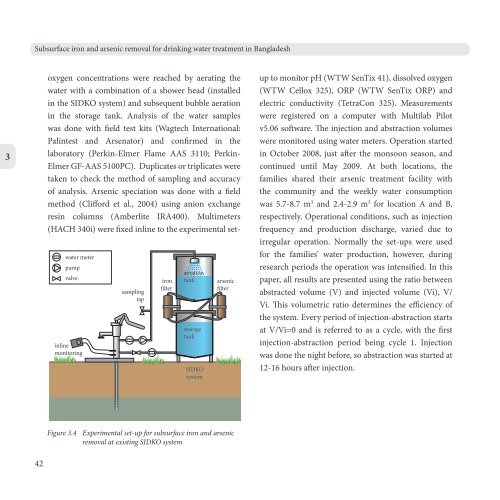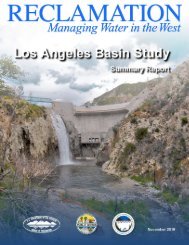Subsurface Iron and Arsenic Removal
qj78kp8
qj78kp8
- No tags were found...
Create successful ePaper yourself
Turn your PDF publications into a flip-book with our unique Google optimized e-Paper software.
<strong>Subsurface</strong> iron <strong>and</strong> arsenic removal for drinking water treatment in Bangladesh<br />
3<br />
water meter<br />
pump<br />
valve<br />
inline<br />
monitoring<br />
sampling<br />
tap<br />
iron<br />
filter<br />
aeration<br />
tank<br />
storage<br />
tank<br />
SIDKO<br />
system<br />
arsenic<br />
filter<br />
oxygen concentrations were reached by aerating the<br />
water with a combination of a shower head (installed<br />
in the SIDKO system) <strong>and</strong> subsequent bubble aeration<br />
in the storage tank. Analysis of the water samples<br />
was done with field test kits (Wagtech International:<br />
Palintest <strong>and</strong> Arsenator) <strong>and</strong> confirmed in the<br />
laboratory (Perkin-Elmer Flame AAS 3110; Perkin-<br />
Elmer GF-AAS 5100PC). Duplicates or triplicates were<br />
taken to check the method of sampling <strong>and</strong> accuracy<br />
of analysis. <strong>Arsenic</strong> speciation was done with a field<br />
method (Clifford et al., 2004) using anion exchange<br />
resin columns (Amberlite IRA400). Multimeters<br />
(HACH 340i) were fixed inline to the experimental setup<br />
to monitor pH (WTW SenTix 41), dissolved oxygen<br />
(WTW Cellox 325), ORP (WTW SenTix ORP) <strong>and</strong><br />
electric conductivity (TetraCon 325). Measurements<br />
were registered on a computer with Multilab Pilot<br />
v5.06 software. The injection <strong>and</strong> abstraction volumes<br />
were monitored using water meters. Operation started<br />
in October 2008, just after the monsoon season, <strong>and</strong><br />
continued until May 2009. At both locations, the<br />
families shared their arsenic treatment facility with<br />
the community <strong>and</strong> the weekly water consumption<br />
was 5.7-8.7 m 3 <strong>and</strong> 2.4-2.9 m 3 for location A <strong>and</strong> B,<br />
respectively. Operational conditions, such as injection<br />
frequency <strong>and</strong> production discharge, varied due to<br />
irregular operation. Normally the set-ups were used<br />
for the families’ water production, however, during<br />
research periods the operation was intensified. In this<br />
paper, all results are presented using the ratio between<br />
abstracted volume (V) <strong>and</strong> injected volume (Vi), V/<br />
Vi. This volumetric ratio determines the efficiency of<br />
the system. Every period of injection-abstraction starts<br />
at V/Vi=0 <strong>and</strong> is referred to as a cycle, with the first<br />
injection-abstraction period being cycle 1. Injection<br />
was done the night before, so abstraction was started at<br />
12-16 hours after injection.<br />
Figure 3.4 Experimental set-up for subsurface iron <strong>and</strong> arsenic<br />
removal at existing SIDKO system<br />
42



